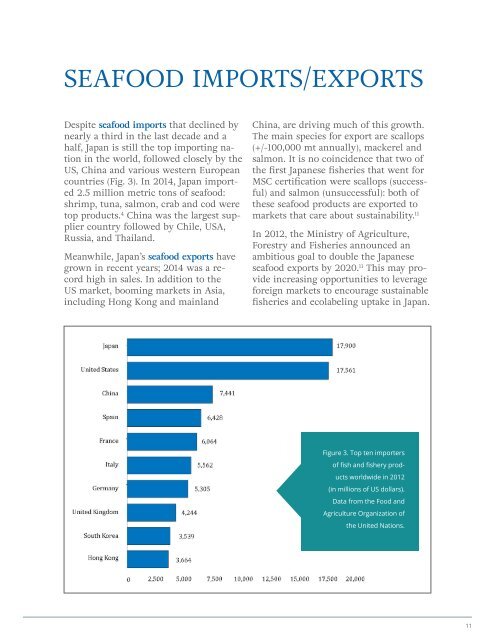OPPORTUNITIES
1WSDsgH
1WSDsgH
Create successful ePaper yourself
Turn your PDF publications into a flip-book with our unique Google optimized e-Paper software.
SEAFOOD IMPORTS/EXPORTS<br />
Despite seafood imports that declined by<br />
nearly a third in the last decade and a<br />
half, Japan is still the top importing nation<br />
in the world, followed closely by the<br />
US, China and various western European<br />
countries (Fig. 3). In 2014, Japan imported<br />
2.5 million metric tons of seafood:<br />
shrimp, tuna, salmon, crab and cod were<br />
top products. 4 China was the largest supplier<br />
country followed by Chile, USA,<br />
Russia, and Thailand.<br />
Meanwhile, Japan’s seafood exports have<br />
grown in recent years; 2014 was a record<br />
high in sales. In addition to the<br />
US market, booming markets in Asia,<br />
including Hong Kong and mainland<br />
China, are driving much of this growth.<br />
The main species for export are scallops<br />
(+/-100,000 mt annually), mackerel and<br />
salmon. It is no coincidence that two of<br />
the first Japanese fisheries that went for<br />
MSC certification were scallops (successful)<br />
and salmon (unsuccessful): both of<br />
these seafood products are exported to<br />
markets that care about sustainability. 11<br />
In 2012, the Ministry of Agriculture,<br />
Forestry and Fisheries announced an<br />
ambitious goal to double the Japanese<br />
seafood exports by 2020. 11 This may provide<br />
increasing opportunities to leverage<br />
foreign markets to encourage sustainable<br />
fisheries and ecolabeling uptake in Japan.<br />
Figure 3. Top ten importers<br />
of fish and fishery products<br />
worldwide in 2012<br />
(in millions of US dollars).<br />
Data from the Food and<br />
Agriculture Organization of<br />
the United Nations.<br />
11



